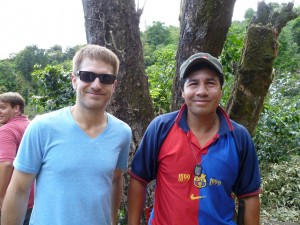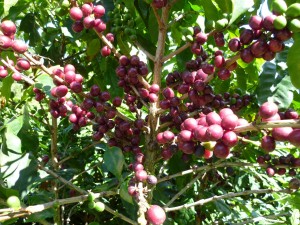Back
El Salvador Trip Part 2
Hey guys!
Sorry for the delay in getting Part 2 of our trip posted. It seems that when you’re trying to open a new store, things get busy!
Anyway… here we go!
Wednesday:
We departed the hotel after a quick breakfast and headed on over to Finca Ayutepeque, a farm owned by Maria Isabel. This was actually a pretty unusual visit, namely because Finca Ayutepeque is not considered a specialty coffee farm. The farm itself resides at 900 meters, meaning that the coffee is too soft, or low grown, to develop some of the interesting characteristics and acidity of higher grown coffee. So why were we here? Good question…
It turns out that Maria began to put herself on the map by focusing on the byproducts of coffee production: cherry pulp and dirty water. Rather than view these waste products as something to get rid of, she saw an opportunity…
Maria began composting her spent cherry, and ended up developing an entirely organic fertilizer that she has begun to sell to other farmers in her area. In addition, she’s had a great amount of success increasing her own coffee yields by using this fertilizer on her own farm.
Now, waste water from coffee processing is a very dangerous environmental hazard. It’s full of sugar, bacteria, organic acids, and other junk that can severely disrupt an ecosystem if it’s allowed to return to the watertable without being treated. However, there can be a lot of really nutritious stuff in there if it’s treated properly.
Before it’s treated, farmers refer to this waste water as “Sopa Bruja”, or witch’s brew. It’s pretty nasty. However, with proper treatment in lagoons, Maria is able to make soil supplements with a focus on important soil nutrients like phosphorus, potassium, nitrogen, etc. It’s actually a really cool system, and Maria’s farm is proof that using organic fertilizers can have a pretty significant effect: her farm’s output of coffee increased from 80,000 pounds in the prior year to 110,000 during what should have been an off year of production using her own fertilizers. Pretty impressive.
After viewing the farm and her composting and treatment techniques, we headed into the onsite house. Maria gave us a short presentation on global climate change and the specific effects it was having in El Salvador. El Salvador actually experienced one of the wettest years ever in 2011, and it definitely played havoc on coffee production.
The seasonal rains (generally, in Octoboer) cause the coffee plants to flower, and even flowering allows for even ripening of the cherries, and efficient picking. However, early rains caused early flowering, causing cherries that matured too soon for picking. In fact, the rains are so far off normal, that we actually saw flowering on several farms during our trip, during harvest! Not normal indeed.
After our trip to Finca Ayutepeque, we travelled over near Santa Ana to a very well-run mill called Cuzcachapa. Cuzcachapa is a cooperatively owned wet and dry mill, and though it does process a good amount of commercial grade coffee, they dry mill a very large amount of extremely good coffee. It is clean, advanced, and efficient.
After they fed us (delicious local hanger steaks), we went and toured the facility, starting in the wet processing area (mostly used for commercial coffees and specialty coffees grown nearby). Seriously, they had drying patios larger than football fields. Pretty amazing.
However, the real treat was the dry mill portion. Specialty coffees are dehulled, sorted by an Oliver table (a table that shakes to separate by density), and that’s pretty much it for specialty coffees that are carefully picked. Commercial coffees also go through an optical sorter to knock out any defects, of which there can be a lot. Some coffees also get hand-sorted.
Cuzcachapa is also an exporter, so as soon as a coffee is dry-milled and ready to ship, it’s bagged into jute (sometimes grain-pro), and packed into shipping containers. Transportation is then arranged to take the containers to port.
Perhaps one of the amazing things about Cuzcachapa is the sheer amount of coffee that is sitting, waiting to be dry-milled. Coffee is left in parchment while it is stored, until an importer comes along and buys it. We’re talking ton after ton after ton of coffee. And it’s all kept separate and labeled by lot to keep everything kosher. Incredible.
After touring the facility, we all headed over to the cupping room, where we got to cup through about 35-40 samples of coffee, including a sample from Finca San Jose, whom we bought from last year. Surprisingly, it was actually really hard to cup these coffees! These coffees were EXTREMELY fresh, most only a few days or weeks off the drying patio. By comparison, most coffees sit in reposo, or in rest, for 30-45 days after drying before they’re cupped by a roaster or importer in the US. You had to look past the grassy and green notes of the coffees to get into the true flavors. Not easy!
After leaving Cuzcachapa, we headed over to downtown Santa Ana for a while, hung out, and had dinner. Overall, a really informative, fun, busy day…
Thursday
Last day of coffee stuff. After breakfast at the hotel, coffee at Viva Espresso (I guess they didn’t hear me say “V60”. Oh well, an americano at least has caffeine in it…), and a quick stop at a tourist market, we headed over to visit two farms owned by Fernando Lima Mena, Finca Santa Elena and Finca Campanula. Incidentally, Fernando Lima is actually the president of the Cuzcachapa Coop. After determining that the bus couldn’t navigate the roads to the farms (seriously, we left a bumper somewhere out there), we hiked about 2 miles to the farm entrances. Well, some of us hiked. Some road in the back of a pickup. I was one of the (un)lucky ones…
We ate a quick lunch of ham and cheese sandwiches, then headed up into Finca Campanula. This was a pretty awesome farm, and I’m proud to say we’ll be buying coffee from this farm this year. This farm resides between 1650 and 1760 meters, and encompasses about 14 acres. The farm itself is all new growth, as the volcano directly above it (Santa Ana) erupted in 2005 and destroyed the entire farm. Luckily, Fernando Lima decided to rebuild. He planted both Pacamara and Bourbon varietals. I got to talk for a bit with the farm manager, Rogelio Palma, and learned about their workers, processing, farm inputs, etc. Pretty cool stuff.
So this pretty much was the end of our time visiting farms and processors in El Salvador. After leaving Finca Campanula, we headed down to Coatepeque Lake, where we stayed at the house of Patricia, our guide, and took a relaxing swim. So nice to hang out after being cramped up in a bus 4-6 hours a day. After hanging out for a few hours and watching the sun set, we headed back to the hotel. Our time was coming to an end.
But not so fast. Our flight didn’t leave til 1:30 the next afternoon! Surely we could find something awesome to do for the morning?! How about the Pacific Ocean? Sounded tempting…
So a few of us packed up in the morning, and took a taxi south to the ocean. We found a small resort we could hang out at, and set up shop. We rented a couple of surfboards, so being the logical thing, I tried to surf. Key word: tried. I caught one wave, got up on one knee… and nearly drowned. It was spectacular. At least I didn’t break a board (sorry, Tim)! Anyway, we relaxed for a while, watched some surfers who actually knew what they were doing, and then left for the airport.
After a lengthy delay due to a bad radar system, we left San Salvador, got stuck overnight in Houston (karma?), and finally made it home Saturday afternoon. Overall, a great trip. 6 days and 16 hours of airlines, taxis, buses, pickup beds, vans, and walking just to learn a little more about our coffee.
Totally worth it.
-Dave











